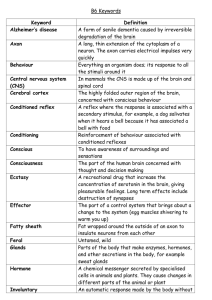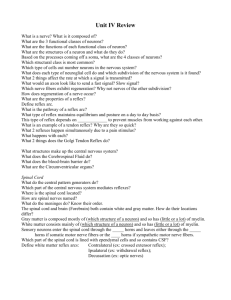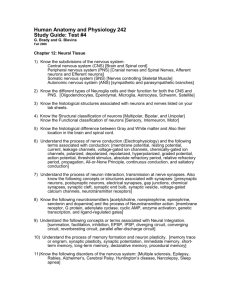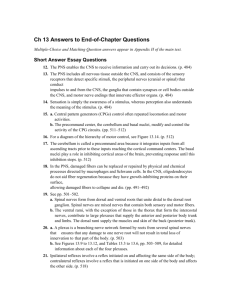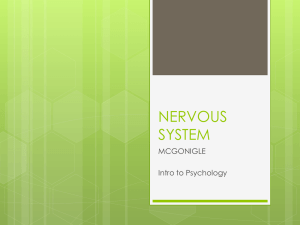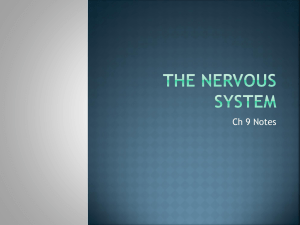File - Coach Albright`s Science Class
advertisement
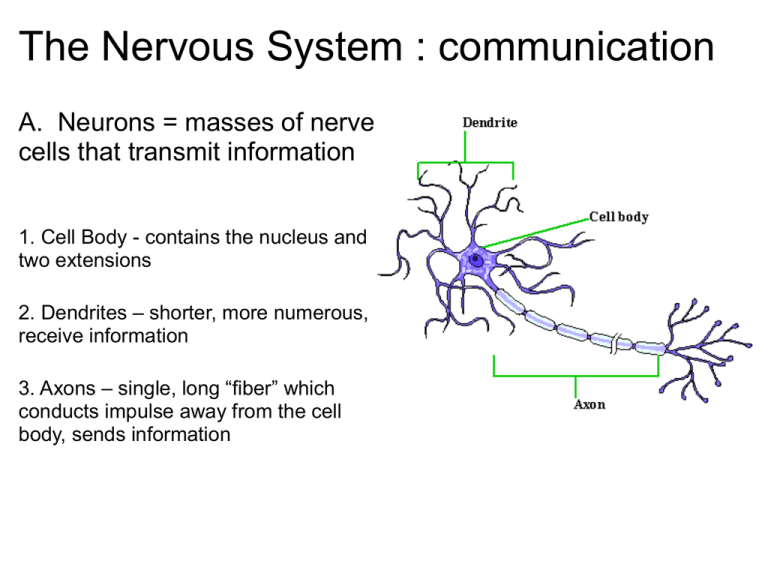
The Nervous System : communication A. Neurons = masses of nerve cells that transmit information 1. Cell Body - contains the nucleus and two extensions 2. Dendrites – shorter, more numerous, receive information 3. Axons – single, long “fiber” which conducts impulse away from the cell body, sends information Nervous System Central Nervous System (CNS): brain and spinal cord. Peripheral Nervous System (PNS): nerves of the body -- Includes 31 pairs of spinal nerves -- And 12 pairs of cranial nerves THREE BASIC FUNCTIONS OF THE NERVOUS SYSTEM • Sensory - gathers info • Integrative - information is brought together • Motor - responds to signals, homeostasis Motor Functions Somatic Nervous System - skeletal (voluntary) Autonomic Nervous System - smooth muscles, glands (involuntary) Neuroglial Cells (p 208) - support cells for the neurons 1. Microglial Cells: scattered throughout, digest debris or bacteria Microglial cells respond to immunological alarms Neuroglial Cells (p 208) 2. Oligodendrocytes: provide insulation around the axons Neuroglial Cells (p 208) 3. Astrocytes: connect blood vessels to neurons I connect to blood vessels Neuroglial Cells (p 208) 4. Ependymal Cells: form a membrane that covers brain-like parts 5. Schwann cells: form the insulating myelin sheath around the neurons Practice with neuroglia coloring! Axon - long section, transmits impulses Dendrite - small extensions from the cell body; receive information Neurofibrils - fibers within the axon • Chromatophilic substance (rough ER) - transport system • Myelin -insulation surrounding axons • Nodes of Ranvier - gaps in the insulation White vs Grey Matter Myelinated (white matter) – myelinated axons Unmyelinated (grey matter) - unmyelinated Label Interesting Facts about the Neuron • Longevity – can live and function for a lifetime • Do not divide – fetal neurons lose their ability to undergo mitosis; neural stem cells are an exception • High metabolic rate – require abundant oxygen and glucose The nerve fibers of newborns are unmyelinated - this causes their responses to stimuli to be course and sometimes involve the whole body. Try surprising a baby! Types of Neurons Functional: Sensory, Motor, Interneurons Structural: (A) Bipolar (B) Unipolar (C) Multipolar Nerve Impulses At rest, the inside of a neuron's membrane has a negative charge. As the figure shows, a Na+ / K+ pump in the cell membrane pumps sodium out of the cell and potassium into it. However, more potassium ions leak out of the cell. As a result, the inside of the membrane builds up a net negative charge relative to the outside. Animations of Nerve Impulses http://highered.mcgrawhill.com/sites/0072495855/student_ view0/chapter14/animation __the_nerve_impulse.html http://outreach.mcb.harvard.edu/ animations/actionpotential.swf The Synapse Synapse - junction between two communicating neurons Nerve pathway - nerve impulse travels from neuron to neuron Synaptic Transmission Dendrite ->cell body -> along axon -> synapse (gap) To complete the signal, a NEUROTRANSMITTER is released at the gap to signal the next neuron Neurotransmitters Excitatory - increase membrane permeability, increases chance for threshold to be achieved Inhibitory - decrease membrane permeability, decrease chance for threshold to be achieved Types of Neurotransmitters • Acetylcholine - stimulates muscle contraction • Monoamines - Norepinephrine & Dopamine (sense of feeling good, low levels = depression) • Serotonin (sleepiness) • Endorphins (reduce pain, inhibit receptors) Antidepressants • Zoloft is part of a class of drugs called selective serotonin reuptake inhibitors, or • SSRIs for short. SSRIs act on a specific chemical within the brain known as serotonin. This is one of several chemicals used to send messages from one nerve cell to another. 9.8 Impulse Processing Neuronal pool - groups of neurons that make hundreds of synaptic connections and work together to perform a common function These "pools" help us remember sequential tasks, like tying a shoe or riding a bike. 9.9 Types of Nerves Sensory Nerves - conduct impulses into the brain or spinal cord Motor Nerves - carry impulses to muscles of glands Mixed Nerves - contain both sensory and motor nerves 9.10 Nerve Pathways • • • • Reflex arc - only includes a few neurons Reflex Behavior - automatic, subconscious responses Knee-jerk reflex - maintains uprightedness Withdrawal reflex - avoidance of painful stimuli • Synapses are highly susceptible to drugs and fatigue • Curare (poison used by S. American Indians) and atropine stops Acetylcholine from depolarising the post-synaptic membrane, i.e. become paralysed. • Strychnine and some nerve gases inhibit or destroy acetylcholinesterase formation. Prolongs and enhances any stimulus, i.e. leads to convulsions, contraction of muscles upon the slightest stimulus. • Cocaine, morphine, alcohol, ether and chloroform anesthetize nerve fibers. (inhibitory) • Mescaline and LSD produce their hallucinatory effect by interfering with nor-adrenaline & serotonin • 9.10 Nerve Pathways • Reflex arc – simple pathway, includes only a few neurons (reflexes) • Reflex Behavior – automatic, subconscious responses to stimulu • Knee-jerk reflex – stimulus knee sensory nerve spinal cord motor nerve • 9.12 Spinal Cord nerve column, passes from brain down through the vertebral canal • - has 31 segments, each with a pair of spinal nerves • 9.13 Brain • Three Major Parts: • Cerebrum – largest, sensory and motor functions, higher mental function (memory, reasoning) • Cerebellum – coordinate voluntary muscles • Brain stem – regulate visceral functions



